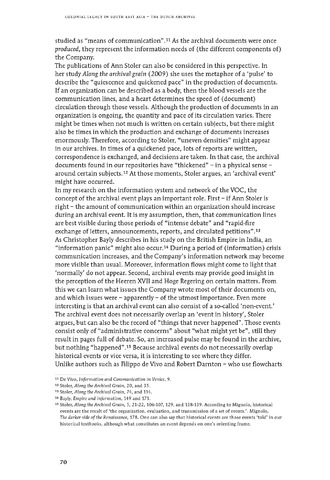studied as "means of communication".11 As the archival documents were once
produced, they represent the information needs of (the different components of)
the Company.
The publications of Ann Stoler can also be considered in this perspective. In
her study Along the archival grain (2009) she uses the metaphor of a 'pulse' to
describe the "quiescence and quickened pace" in the production of documents.
If an organization can be described as a body, then the blood vessels are the
communication lines, and a heart determines the speed of (document)
circulation through those vessels. Although the production of documents in an
organization is ongoing, the quantity and pace of its circulation varies. There
might be times when not much is written on certain subjects, but there might
also be times in which the production and exchange of documents increases
enormously. Therefore, according to Stoler, "uneven densities" might appear
in our archives. In times of a quickened pace, lots of reports are written,
correspondence is exchanged, and decisions are taken. In that case, the archival
documents found in our repositories have "thickened" - in a physical sense -
around certain subjects.12 At those moments, Stoler argues, an 'archival event'
might have occurred.
In my research on the information system and network of the VOC, the
concept of the archival event plays an important role. First - if Ann Stoler is
right - the amount of communication within an organization should increase
during an archival event. It is my assumption, then, that communication lines
are best visible during those periods of "intense debate" and "rapid-fire
exchange of letters, announcements, reports, and circulated petitions".13
As Christopher Bayly describes in his study on the British Empire in India, an
"information panic" might also occur.14 During a period of (information) crisis
communication increases, and the Company's information network may become
more visible than usual. Moreover, information flows might come to light that
'normally' do not appear. Second, archival events may provide good insight in
the perception of the Heeren XVII and Hoge Regering on certain matters. From
this we can learn what issues the Company wrote most of their documents on,
and which issues were - apparently - of the utmost importance. Even more
interesting is that an archival event can also consist of a so-called 'non-event.'
The archival event does not necessarily overlap an 'event in history', Stoler
argues, but can also be the record of "things that never happened". Those events
consist only of "administrative concerns" about "what might yet be", still they
result in pages full of debate. So, an increased pulse may be found in the archive,
but nothing "happened".15 Because archival events do not necessarily overlap
historical events or vice versa, it is interesting to see where they differ.
Unlike authors such as Filippo de Vivo and Robert Darnton - who use flowcharts
COLONIAL LEGACY IN SOUTH EAST ASIA -
THE DUTCH ARCHIVES
11 De Vivo, Information and Communication in Venice, 9.
12 Stoler, Along the Archival Grain, 20, and 35.
13 Stoler, Along the Archival Grain, 74, and 114.
14 Bayly, Empire and information, 149 and 171.
15 Stoler, Along the Archival Grain, 5, 21-22, 106-107, 129, and 138-139. According to Mignolo, historical
events are the result of 'the organization, evaluation, and transmission of a set of events.'. Mignolo,
The darker side of the Renaissance, 178. One can also say that historical events are those events 'told' in our
historical textbooks, although what constitutes an event depends on one's orienting frame.
70

